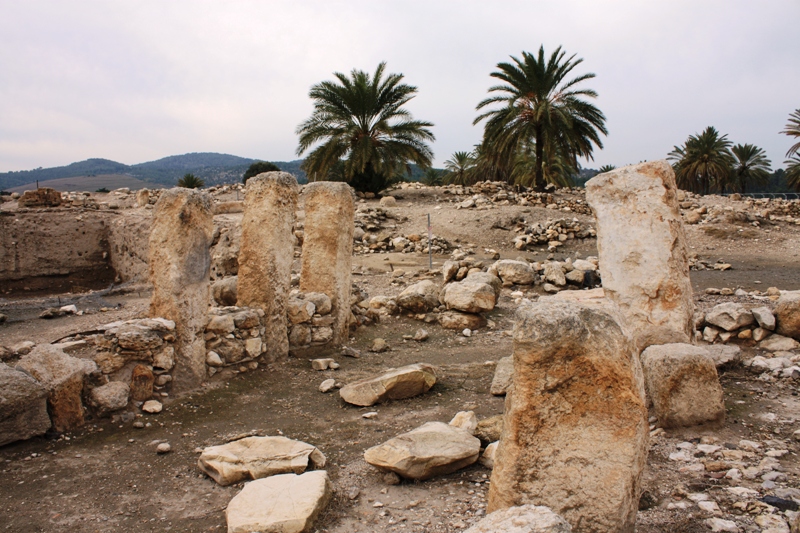Summer Excavations in Israel: Tel Megiddo and Tel Azekah / Benjamin Douglass
Tel Megiddo
The Megiddo Expedition, run by co-directors Prof. Israel Finkelstein, Matthew Adams, and Mario Martin, is an excavation that runs every other season. It began in the early 1990s and aimed at getting a better understanding of the history, stratigraphy, and importance of the famous site. The excavation is partnered with organizations from around the world and works closely with the European Research Council and Jezreel Valley Regional Project. For an overview of the site, see my previous blog post about the TAU tour there this past year. Delegations of volunteers come from all over the world, including Israel, China, and the US to work at the Megiddo site. This year, half of the International MA students from Tel Aviv University attended the expedition as well, some of them getting their first ever taste of field archaeology.

The focus of the expedition this year was on a few areas of the tel. Areas H, K, and Q were manned, and a new area, X was opened. Every morning at 4:30am the sleepy volunteers would wake up, shuffle onto the buses, and travel to site. The volunteers worked diligently until the early afternoon, only stopping a few times for snacks and breakfast. After their return to the kibbutz and a quick rest, pottery wash and classes were held. Lectures were held by members of the staff as well as guests, with topics ranging from ancient stone working techniques to the history and importance of the Jezreel Valley. After dinner most participants went straight to bed, hoping to get a good night’s sleep before waking up early to start the process over again!
By the end of the excavation, most of the volunteers had the system down well. The excavations were a success, and much was learned. Many exciting features and artifacts were discovered in the different areas. Area Q, an area with metallurgical and cultic finds, was closed at the end of the excavations. Area X, a new domestic area, successfully yielded remains from the late Iron Age, a period not well understood archaeologically at Megiddo thanks to the thorough excavations by the University of Chicago in the early 20th century. Areas H and K continued to reveal their secrets as the excavations approached the Early and Middle Bronze Age occupation layers. Even though I only spent 1 short week excavating at Megiddo, I experienced a lot of what the site and the excavation had to offer. I learned a great deal from the directors, the staff, and the other volunteers. If you would like to learn more about this site, be sure to visit the expedition’s website at megiddo.tau.ac.il for news and updates about past and future excavation seasons!
Tel Azekah
The Lautenschlager Azekah Expedition is run by Prof. Oded Lipschits and Dr. Yuval Gadot of Tel Aviv University, and Prof. Manfred Oeming of Heidelberg University. The excavation at the site begun in 2012, and this past season was the 5th consecutive year of excavations. The expedition works closely with other organizations abroad, including Macquarie University in Australia, Heidelberg and Oldenburg Universities in Germany, and other universities in Europe and the US.

International MA student Benjamin Douglass at Azekah
Azekah Dig
Field Work
This year the areas being excavated were N1, W1/T1, T2, S2, and E3. The main focus of the expedition was to find the remains of the Iron Age, a period that had so far remained relatively elusive archaeologically. Just like at Megiddo, the volunteers’ morning began with a 4:30 AM wake up call, after which they arrived at the site. Everyone worked hard until breakfast at 9AM, and then after breakfast until the return home at 1PM. Immediately upon returning to the kibbutz, everyone participated in pottery and bone wash and then went to lunch. In the afternoons and evenings, we had some time to ourselves, followed by lectures, classes, and tours to nearby important sites. Every day was always full of information and very busy.

International MA student Jenna at Azekah
Findings
At the end of a successful excavations season, area S2 was closed after its water cistern and surrounding area were better understood. Areas N1 and W1/T1 revealed many interesting finds and new information regarding the Middle Bronze Age and Iron Age settlements. The Late Bronze destruction at Area T2 was further revealed and its architecture uncovered. Finally, E3, the infamous slope, began to reveal that it might be the siege ramp used by the Assyrians in their campaign in 701 BCE. If you would like to learn more about the site and the history of excavations at Azekah, azekah.org will give you some of the insider’s info.
Findings at Azekah
Life at Azekah was full of activities, with weekly pool parties, lectures, and plenty of social time. The volunteers had a wonderful time learning, working, and making new international friends. It was great to see students from Australia, Germany, the US, and other countries mingling with the BA and MA students from Tel Aviv. Many people will miss attending these excavations next summer.
Azekah
August 2016


